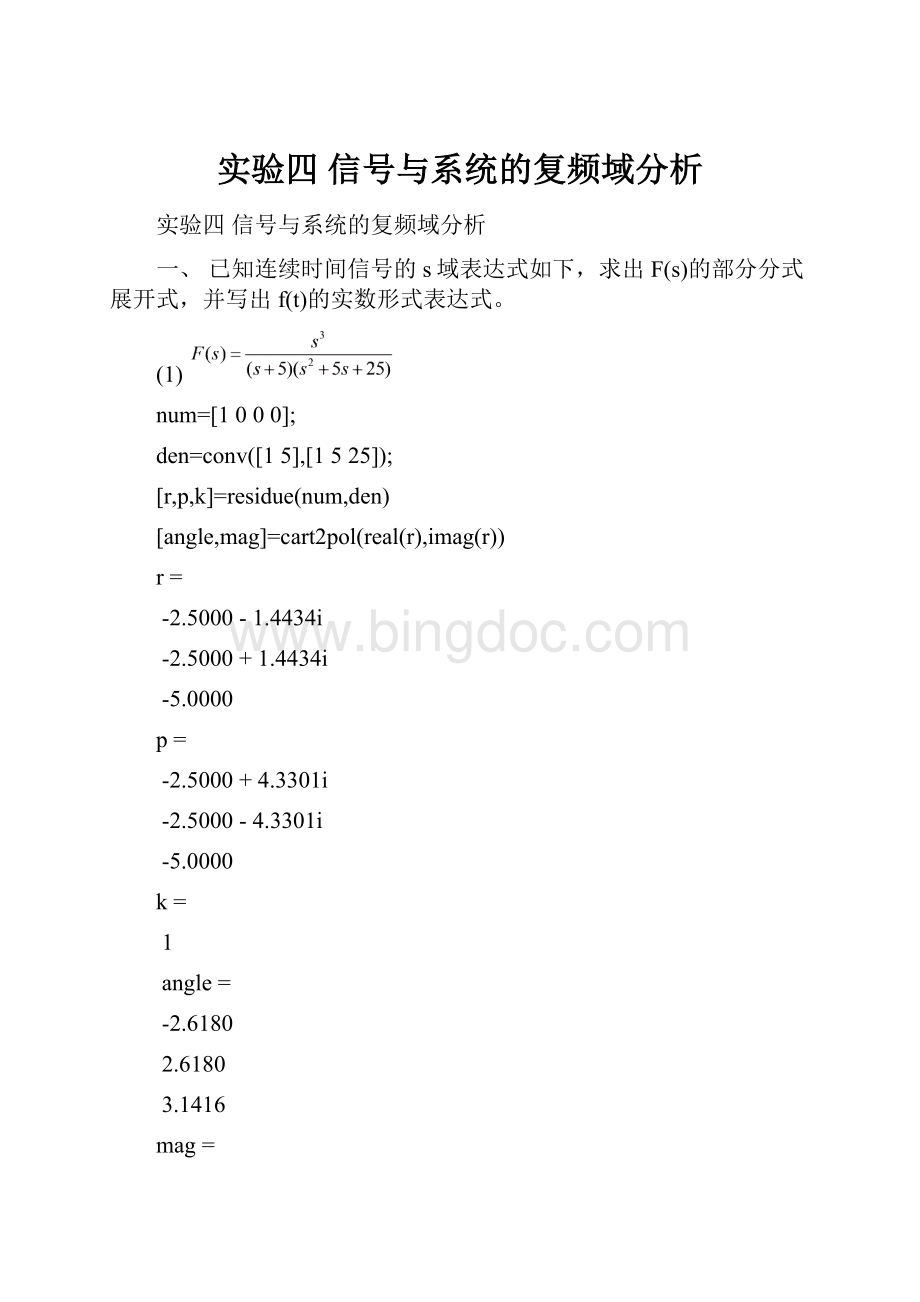实验四 信号与系统的复频域分析.docx
《实验四 信号与系统的复频域分析.docx》由会员分享,可在线阅读,更多相关《实验四 信号与系统的复频域分析.docx(13页珍藏版)》请在冰点文库上搜索。

实验四信号与系统的复频域分析
实验四信号与系统的复频域分析
一、已知连续时间信号的s域表达式如下,求出F(s)的部分分式展开式,并写出f(t)的实数形式表达式。
(1)
num=[1000];
den=conv([15],[1525]);
[r,p,k]=residue(num,den)
[angle,mag]=cart2pol(real(r),imag(r))
r=
-2.5000-1.4434i
-2.5000+1.4434i
-5.0000
p=
-2.5000+4.3301i
-2.5000-4.3301i
-5.0000
k=
1
angle=
-2.6180
2.6180
3.1416
mag=
2.8868
2.8868
5.0000
(2)
num=[833.3025];
den=conv([14.112328.867],[19.927928.867]);
[r,p]=residue(num,den)
[angle,mag]=cart2pol(real(r),imag(r))
r=
2.4819-5.9928i
2.4819+5.9928i
-2.4819+1.0281i
-2.4819-1.0281i
p=
-4.9640+2.0558i
-4.9640-2.0558i
-2.0562+4.9638i
-2.0562-4.9638i
angle=
-1.1782
1.1782
2.7489
-2.7489
mag=
6.4864
6.4864
2.6864
2.6864
二、归一化的Butterworth滤波器的系统函数为
。
(1)求出H(s)的部分分式展开式,并写出h(t)的实数形式表达式;
num=[1];
den=conv([12*sin(pi/8)1],[12*sin(3*pi/8)1]);
[r,p]=residue(num,den)
[angle,mag]=cart2pol(real(r),imag(r))
r=
-0.4619+0.1913i
-0.4619-0.1913i
0.4619-1.1152i
0.4619+1.1152i
p=
-0.3827+0.9239i
-0.3827-0.9239i
-0.9239+0.3827i
-0.9239-0.3827i
angle=
2.7489
-2.7489
-1.1781
1.1781
mag=
0.5000
0.5000
1.2071
1.2071
(2)用impulse求出其h(t),并和
(1)中的结果进行比较。
num=[1];
den=conv([12*sin(pi/8)1],[12*sin(3*pi/8)1]);
sys=tf(num,den);
t=0:
0.02:
10;
h=impulse(sys,t);
plot(t,h);
title('ImpulseResponse')
三、已知信号系统函数
,试分别画出
时系统的零极点图。
如果系统是稳定的,画出系统的幅度响应曲线。
系统极点的位置对系统幅度响应有何影响?
程序:
a=input('a=');
num=[1];
den=[12*a1];
sys=tf(num,den);
poles=roots(den)
pzmap(sys);
(1)系统不是稳定的
a=0F(s)=1/(s^2+1)
num=[1];
den=[101];
sys=tf(num,den);
poles=roots(den)
pzmap(sys);
poles=
0+1.0000i
0-1.0000i
(2)系统是稳定的
a=1/4F(s)=1/(s^2+1/2*s+1)
num=[1];
den=[11/21];
sys=tf(num,den);
poles=roots(den)
figure
(1);pzmap(sys);
w=linspace(0,5,200);
F=freqs(num,den,w);
figure
(2);plot(w,abs(F));
poles=
-0.2500+0.9682i
-0.2500-0.9682i
(3)系统是稳定的
a=1
num=[1];
den=[121];
sys=tf(num,den);
poles=roots(den)
figure
(1);pzmap(sys);
w=linspace(0,5,200);
F=freqs(num,den,w);
figure
(2);plot(w,abs(F));
poles=
-1
-1
(4)系统是稳定的
a=2
num=[1];
den=[141];
sys=tf(num,den);
poles=roots(den)
figure
(1);pzmap(sys);
w=linspace(0,5,200);
F=freqs(num,den,w);
figure
(2);plot(w,abs(F));
poles=
-3.7321
-0.2679
四、已知
,画出该系统的零极点分布图,求出系统的冲激响应、阶跃响应和频率响应。
num=[12];
den=[1221];
sys=tf(num,den);
poles=roots(den)
figure
(1);pzmap(sys);
t=0:
0.02:
10;
h=impulse(num,den,t);
figure
(2);plot(t,h);
title('ImpulseResponse')
t=0:
0.02:
10;
s=step(num,den,t);
figure(3);plot(t,s);
title('StepResponse')
[H,w]=freqs(num,den);
figure(4);plot(w,abs(H));
xlabel('\omega')
title('MagnitadeResponse')
poles=
-1.0000
-0.5000+0.8660i
-0.5000-0.8660i